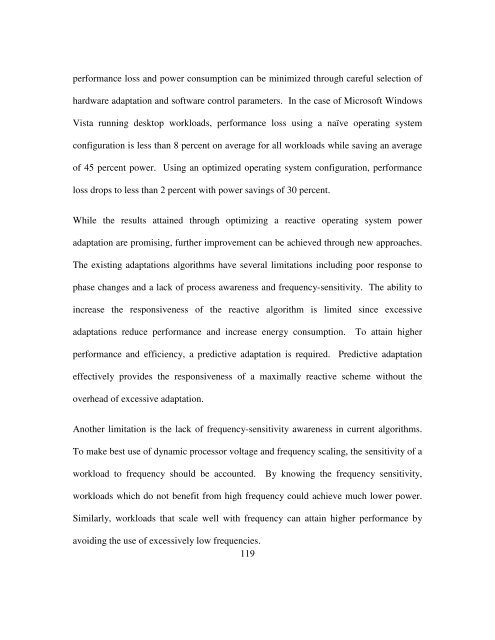Copyright by William Lloyd Bircher 2010 - The Laboratory for ...
Copyright by William Lloyd Bircher 2010 - The Laboratory for ...
Copyright by William Lloyd Bircher 2010 - The Laboratory for ...
You also want an ePaper? Increase the reach of your titles
YUMPU automatically turns print PDFs into web optimized ePapers that Google loves.
per<strong>for</strong>mance loss and power consumption can be minimized through careful selection of<br />
hardware adaptation and software control parameters. In the case of Microsoft Windows<br />
Vista running desktop workloads, per<strong>for</strong>mance loss using a naïve operating system<br />
configuration is less than 8 percent on average <strong>for</strong> all workloads while saving an average<br />
of 45 percent power. Using an optimized operating system configuration, per<strong>for</strong>mance<br />
loss drops to less than 2 percent with power savings of 30 percent.<br />
While the results attained through optimizing a reactive operating system power<br />
adaptation are promising, further improvement can be achieved through new approaches.<br />
<strong>The</strong> existing adaptations algorithms have several limitations including poor response to<br />
phase changes and a lack of process awareness and frequency-sensitivity. <strong>The</strong> ability to<br />
increase the responsiveness of the reactive algorithm is limited since excessive<br />
adaptations reduce per<strong>for</strong>mance and increase energy consumption. To attain higher<br />
per<strong>for</strong>mance and efficiency, a predictive adaptation is required. Predictive adaptation<br />
effectively provides the responsiveness of a maximally reactive scheme without the<br />
overhead of excessive adaptation.<br />
Another limitation is the lack of frequency-sensitivity awareness in current algorithms.<br />
To make best use of dynamic processor voltage and frequency scaling, the sensitivity of a<br />
workload to frequency should be accounted. By knowing the frequency sensitivity,<br />
workloads which do not benefit from high frequency could achieve much lower power.<br />
Similarly, workloads that scale well with frequency can attain higher per<strong>for</strong>mance <strong>by</strong><br />
avoiding the use of excessively low frequencies.<br />
119




